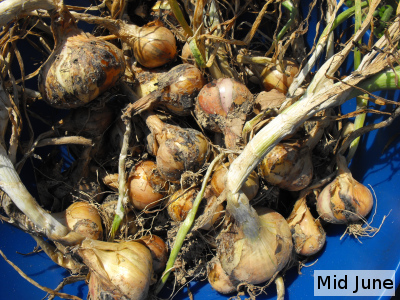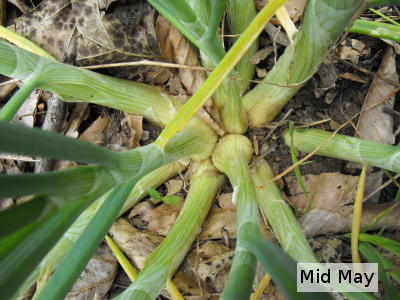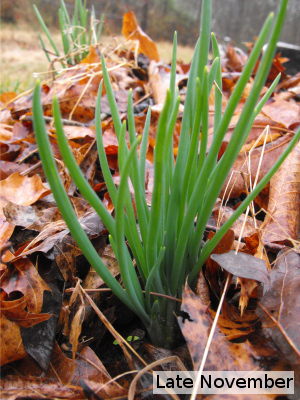
Potato onion bulb size
 I was thrilled to learn about
multiplier
onions a year ago, a category that includes both shallots and potato onions.
The latter is potentially a replacement for the pesky storage onion, a
crop that most small gardeners grow from expensive sets that produce
bulbs with a short storage life, or from seeds that are often difficult
to germinate and are picky about soil. Potato onions promise to
replace both of those problematic storage onions with a type that is as
simple to grow as garlic --- just save some bulbs every year to toss
back in the soil and seed next year's crop.
I was thrilled to learn about
multiplier
onions a year ago, a category that includes both shallots and potato onions.
The latter is potentially a replacement for the pesky storage onion, a
crop that most small gardeners grow from expensive sets that produce
bulbs with a short storage life, or from seeds that are often difficult
to germinate and are picky about soil. Potato onions promise to
replace both of those problematic storage onions with a type that is as
simple to grow as garlic --- just save some bulbs every year to toss
back in the soil and seed next year's crop.
 Unfortunately,
the results of my
first year of experimentation were not that great. I ended
up with a lot of little potato onions that were too small to consider
eating, and just a few big onions. Figuring that I might
have
planted them too late in the fall for optimal results, I turned around
and put
every single bulb back in the ground this September, but I
wasn't all that confident that I'd get onions that were worth my
while.
Unfortunately,
the results of my
first year of experimentation were not that great. I ended
up with a lot of little potato onions that were too small to consider
eating, and just a few big onions. Figuring that I might
have
planted them too late in the fall for optimal results, I turned around
and put
every single bulb back in the ground this September, but I
wasn't all that confident that I'd get onions that were worth my
while.

Eric Toensmeier clued me
in to some information about
potato onions that makes me much more confident of my results. He
wrote that if you plant small bulbs, they turn into one to two large
bulbs by the next year, while if you plant big bulbs, each one instead
turns into up to a dozen small bulbs. The trick is to always
plant a mixture of both large and small bulbs in your garden --- the
former will produce seed bulbs for replanting while the latter will
produce your eating onions for that year. If he's right, we
should have lots of big bulbs come spring and just a few small bulbs
for replanting. Assuming that Toensmeier knows what he's writing
about, potato onions may be the salvation of our garden after all.
| This post is part of our Perennial Vegetables lunchtime series.
Read all of the entries: |
Want more in-depth information? Browse through our books.
Or explore more posts by date or by subject.
About us: Anna Hess and Mark Hamilton spent over a decade living self-sufficiently in the mountains of Virginia before moving north to start over from scratch in the foothills of Ohio. They've experimented with permaculture, no-till gardening, trailersteading, home-based microbusinesses and much more, writing about their adventures in both blogs and books.
Want to be notified when new comments are posted on this page? Click on the RSS button after you add a comment to subscribe to the comment feed, or simply check the box beside "email replies to me" while writing your comment.
